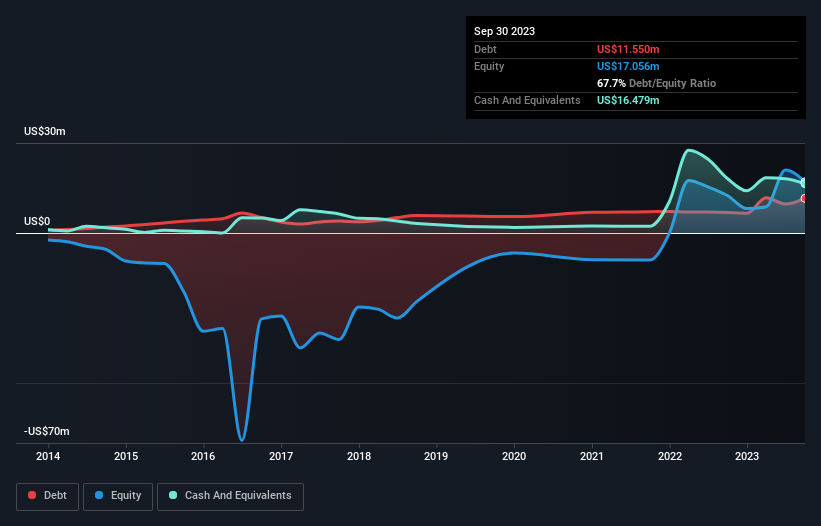Legendary fund manager Li Lu (who Charlie Munger backed) once said, 'The biggest investment risk is not the volatility of prices, but whether you will suffer a permanent loss of capital.' So it might be obvious that you need to consider debt, when you think about how risky any given stock is, because too much debt can sink a company. We note that SKYX Platforms Corp. (NASDAQ:SKYX) does have debt on its balance sheet. But the more important question is: how much risk is that debt creating?
Why Does Debt Bring Risk?
Debt and other liabilities become risky for a business when it cannot easily fulfill those obligations, either with free cash flow or by raising capital at an attractive price. In the worst case scenario, a company can go bankrupt if it cannot pay its creditors. However, a more usual (but still expensive) situation is where a company must dilute shareholders at a cheap share price simply to get debt under control. Having said that, the most common situation is where a company manages its debt reasonably well - and to its own advantage. The first step when considering a company's debt levels is to consider its cash and debt together.
View our latest analysis for SKYX Platforms
What Is SKYX Platforms's Net Debt?
You can click the graphic below for the historical numbers, but it shows that as of September 2023 SKYX Platforms had US$11.6m of debt, an increase on US$6.82m, over one year. But on the other hand it also has US$16.5m in cash, leading to a US$4.93m net cash position.

A Look At SKYX Platforms' Liabilities
The latest balance sheet data shows that SKYX Platforms had liabilities of US$31.3m due within a year, and liabilities of US$30.0m falling due after that. Offsetting this, it had US$16.5m in cash and US$3.03m in receivables that were due within 12 months. So its liabilities outweigh the sum of its cash and (near-term) receivables by US$41.8m.
SKYX Platforms has a market capitalization of US$130.0m, so it could very likely raise cash to ameliorate its balance sheet, if the need arose. But it's clear that we should definitely closely examine whether it can manage its debt without dilution. Despite its noteworthy liabilities, SKYX Platforms boasts net cash, so it's fair to say it does not have a heavy debt load! When analysing debt levels, the balance sheet is the obvious place to start. But ultimately the future profitability of the business will decide if SKYX Platforms can strengthen its balance sheet over time. So if you're focused on the future you can check out this free report showing analyst profit forecasts.
While it hasn't made a profit, at least SKYX Platforms booked its first revenue as a publicly listed company, in the last twelve months.
So How Risky Is SKYX Platforms?
We have no doubt that loss making companies are, in general, riskier than profitable ones. And in the last year SKYX Platforms had an earnings before interest and tax (EBIT) loss, truth be told. And over the same period it saw negative free cash outflow of US$15m and booked a US$32m accounting loss. But at least it has US$4.93m on the balance sheet to spend on growth, near-term. Summing up, we're a little skeptical of this one, as it seems fairly risky in the absence of free cashflow. When analysing debt levels, the balance sheet is the obvious place to start. However, not all investment risk resides within the balance sheet - far from it. These risks can be hard to spot. Every company has them, and we've spotted 2 warning signs for SKYX Platforms you should know about.
At the end of the day, it's often better to focus on companies that are free from net debt. You can access our special list of such companies (all with a track record of profit growth). It's free.
New: Manage All Your Stock Portfolios in One Place
We've created the ultimate portfolio companion for stock investors, and it's free.
• Connect an unlimited number of Portfolios and see your total in one currency
• Be alerted to new Warning Signs or Risks via email or mobile
• Track the Fair Value of your stocks
Have feedback on this article? Concerned about the content? Get in touch with us directly. Alternatively, email editorial-team (at) simplywallst.com.
This article by Simply Wall St is general in nature. We provide commentary based on historical data and analyst forecasts only using an unbiased methodology and our articles are not intended to be financial advice. It does not constitute a recommendation to buy or sell any stock, and does not take account of your objectives, or your financial situation. We aim to bring you long-term focused analysis driven by fundamental data. Note that our analysis may not factor in the latest price-sensitive company announcements or qualitative material. Simply Wall St has no position in any stocks mentioned.
About NasdaqCM:SKYX
SKYX Platforms
Provides a series of safe-smart platform technologies in the United States.
Slightly overvalued with imperfect balance sheet.
Similar Companies
Market Insights
Community Narratives




